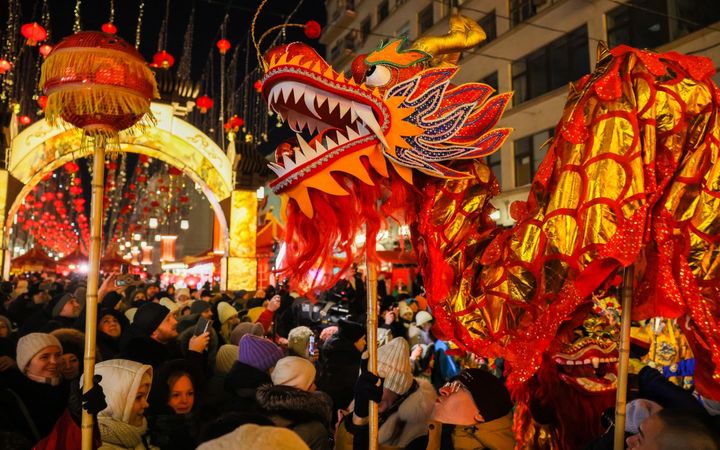China, a land steeped in history and tradition, boasts a vibrant tapestry of festivals that reflect its rich cultural heritage. From the dazzling spectacle of Chinese New Year to the serene beauty of the Mid-Autumn Festival, each celebration offers a unique window into the heart of Chinese culture. This beginner’s guide will introduce you to some of the most popular Chinese festivals, their significance, and how they are celebrated.
Chinese New Year: A Celebration of Renewal and Reunion
Marking the beginning of the lunar new year, Chinese New Year, also known as Spring Festival, is the most important and widely celebrated festival in China. It’s a time for family reunions, feasting, and wishing for good fortune in the year ahead.
Traditions and Customs: Houses are thoroughly cleaned to sweep away bad luck, and red decorations adorn doors and windows to ward off evil spirits. Families gather for lavish feasts featuring dishes symbolizing prosperity and good luck, such as fish and dumplings. Fireworks light up the night sky, and children receive red envelopes filled with money for good luck.
Significance: Chinese New Year symbolizes new beginnings, family unity, and the hope for a prosperous and harmonious year.
Mid-Autumn Festival: A Time for Mooncakes and Reunion
Celebrated on the 15th day of the 8th lunar month, the Mid-Autumn Festival, also known as the Moon Festival, is a time for family reunions and appreciating the beauty of the full moon.
Traditions and Customs: Families gather to admire the moon, share stories, and indulge in mooncakes, round pastries filled with sweet or savory ingredients. Lanterns of all shapes and sizes illuminate the night, and children carry them in parades. The legend of Chang’e, the moon goddess, is often recounted during this time.
Significance: The Mid-Autumn Festival celebrates the harvest, family unity, and the beauty of the moon, symbolizing completeness and reunion.
Dragon Boat Festival: Racing to Commemorate a Poet
Held on the 5th day of the 5th lunar month, the Dragon Boat Festival, also known as Duanwu Festival, is a lively celebration featuring dragon boat races and the consumption of zongzi, pyramid-shaped dumplings wrapped in bamboo leaves.
Traditions and Customs: The highlight of the festival is the exhilarating dragon boat races, where teams paddle in unison to the rhythm of drums. Zongzi, filled with sticky rice, meat, and other ingredients, are enjoyed as a traditional delicacy. People also hang calamus and wormwood on their doors to ward off evil spirits.
Significance: The Dragon Boat Festival commemorates the life and death of Qu Yuan, a patriotic poet who drowned himself in protest against government corruption. It symbolizes patriotism, loyalty, and the importance of standing up for what is right.
Lantern Festival: Illuminating the Night with Hope
Marking the end of the Chinese New Year celebrations, the Lantern Festival, also known as Yuanxiao Festival, falls on the 15th day of the first lunar month. It’s a night of dazzling lantern displays, riddle guessing, and sweet treats.
Traditions and Customs: Streets and homes are adorned with colorful lanterns of all shapes and sizes, often depicting animals, flowers, and scenes from folklore. People gather to solve riddles written on lanterns and enjoy tangyuan, sweet glutinous rice balls symbolizing family unity and happiness.
Significance: The Lantern Festival signifies the end of the New Year festivities and the beginning of spring. It represents hope, good fortune, and the pursuit of happiness.
Qingming Festival: Honoring Ancestors and Embracing Spring
Observed on the 15th day after the Spring Equinox, Qingming Festival, also known as Tomb-Sweeping Day, is a time for honoring ancestors and embracing the arrival of spring.
Traditions and Customs: Families visit the graves of their ancestors to clean the tombstones, offer food and flowers, and burn incense as a sign of respect. It’s also a time for outdoor activities, such as flying kites and enjoying the beauty of nature.
Significance: Qingming Festival emphasizes the importance of filial piety, remembrance, and the connection between the living and the dead. It also celebrates the renewal of life and the beauty of spring.
Chinese festivals are a vibrant tapestry woven with tradition, symbolism, and cultural significance. From the joyous celebrations of Chinese New Year to the serene beauty of the Mid-Autumn Festival, each event offers a unique glimpse into the heart of Chinese culture. By understanding and appreciating these festivals, we gain a deeper appreciation for the richness and diversity of Chinese heritage.
Call to Action:
Explore more about Chinese culture and traditions by visiting our website.
Share your experiences of Chinese festivals in the comments below.
Subscribe to our newsletter for more insights into Chinese culture.